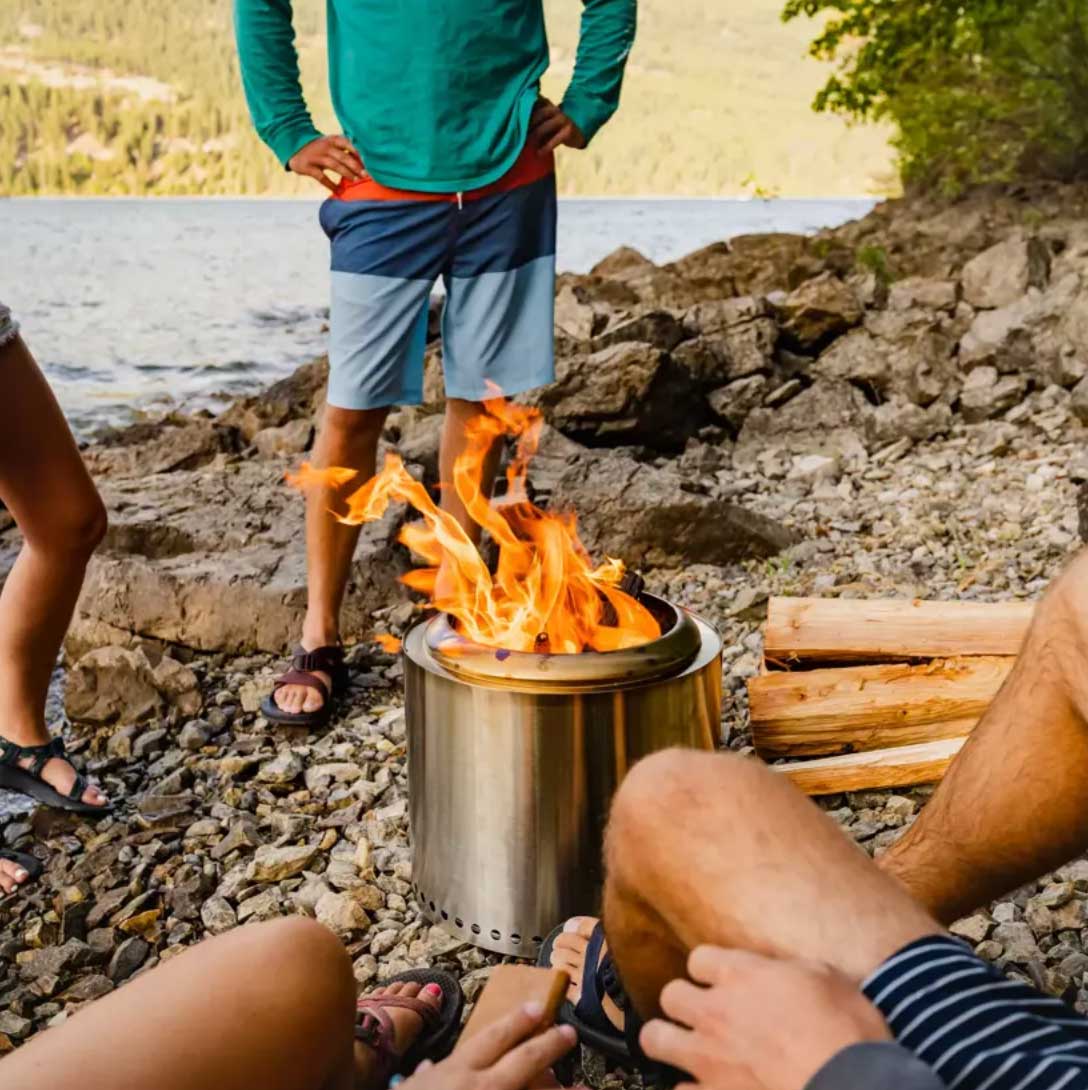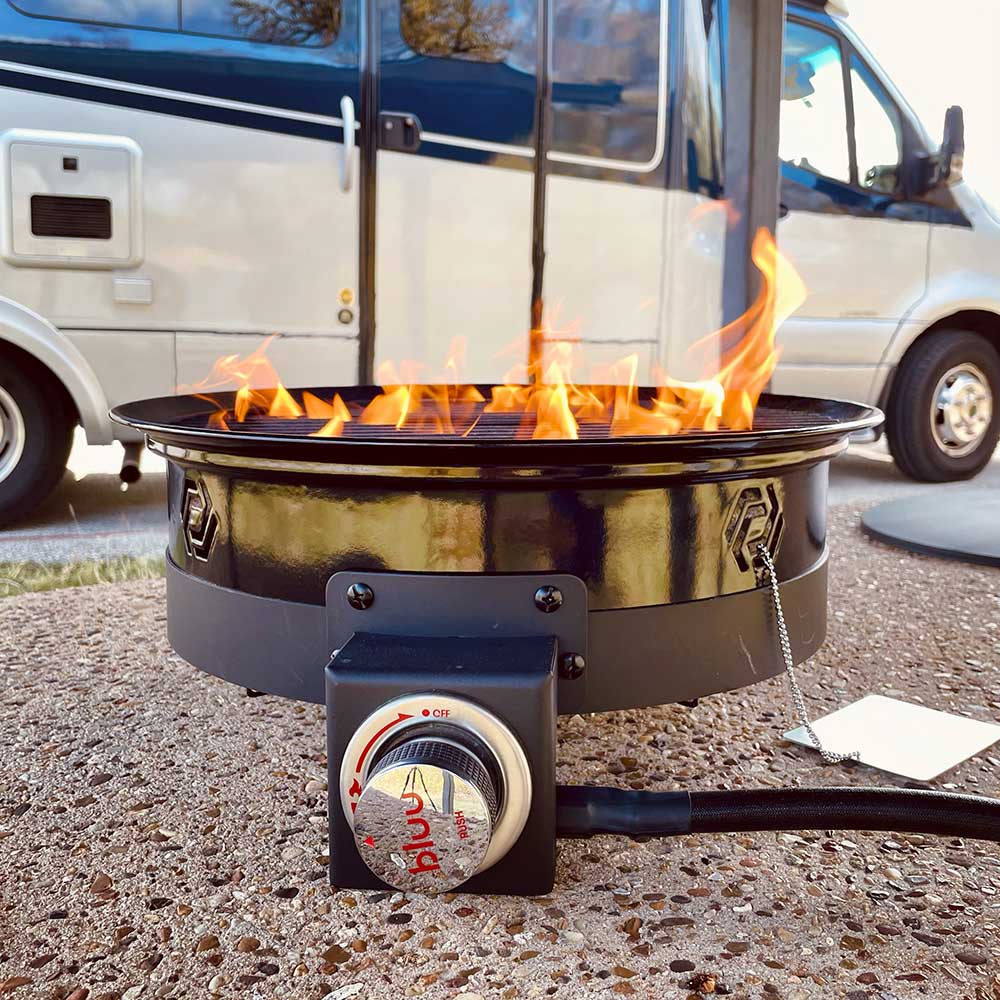Editor’s Note: This post is written by a member of LTV’s sponsored content team, The Leisure Explorers. Do you own a Leisure Travel Van and enjoy writing? Learn more about joining the team.
When Janet and I set out in our Unity FX, our goal is to see something new and enjoy the outdoors. One of those ways of enjoying the outdoors is to sit around our portable fire pit in the evenings.
We have a propane fire pit; however, I know so many folks who love their wood-burning pits, which have come a long way lately in both design and size. So in this story, I will discuss the different types of fire pits that can be used for an RV and the differences between propane and wood-burning fire pits.

Propane Fire Pits
Propane fire pits are an excellent option for RVers who want a hassle-free fire pit experience. These fire pits are powered by propane, a clean-burning fuel that produces no smoke or ash. The most significant advantage of propane fire pits is their convenience. They are easy to start, require no maintenance, and can be turned off with the flick of a switch. And many RVs have an external propane port to attach your fire pit to your onboard propane easily.
The propane fire pit we carry is from BLUU, and it has been fantastic. The construction is durable, lights easily, and has a cast iron grate for cooking or heating up a kettle. We’ve been really happy with the BLUU, but if you are looking for something even smaller, check out the Ignik FireCan.
Ignik’s super compact fire can is a popular choice that makes high-quality propane fire solutions that will fit in most RV storage bays. Their fire pits come with a built-in regulator and an eight-foot hose that connects to standard propane bottles, making them easy to use and transport. Ignik’s fire pits also feature a stainless steel burner that produces up to 38,000 BTUs of heat, making them ideal for chilly nights.
One of the downsides of propane fire pits is that they can be a bit more expensive to operate. Propane fuel is generally more expensive than wood, and you’ll need to refill your propane bottles periodically. However, if convenience is your top priority, propane fire pits are an excellent choice.
Also, many RVs (including our Leisure Travel Van) have regulated propane outlets. You must have a non-regulated fire pit (or hose) to work with the portable fire pit. (Regulated means that the propane output is limited, so having two regulators between your propane source and fire pit won’t allow enough propane to fuel the fire).
When we use our BLUU fire pit, we use the Ignik 10-pound propane bottle that allows us to carry our fire pit away from the RV and use anywhere we like. Interested in what we carry with us in our LTV? Check out PagosaSupply.Co
Wood-Burning Fire Pits
Wood-burning fire pits are a classic option that many RVers prefer. These fire pits burn wood, which is abundant, inexpensive, and widely available. One of the most significant advantages of wood-burning fire pits is the natural ambiance they provide. The crackling sound of burning wood and the smell of wood smoke can create a cozy, rustic atmosphere.
Solo Stove is a popular brand that makes high-quality wood-burning fire pits ideal for RV use. Their fire pits feature a unique design that maximizes airflow, resulting in a more efficient burn and less smoke. Solo Stove fire pits also feature a lightweight, portable design, making them easy to transport from one campsite to another. They even make a Solo Stove tabletop version for more storability.

One of the downsides of wood-burning fire pits is that they require more maintenance than propane fire pits. You’ll need to gather and store wood, start the fire, and regularly clean out the ashes. Wood-burning fire pits also produce smoke, which can be a nuisance for nearby campers or RVs. However, if you value the natural ambiance and low cost of wood fuel, a wood-burning fire pit may be the right choice.
Another downside of some wood-burning fire pits is the size can be too large for an outdoor storage bay of an RV, and the fire smell is not conducive for carrying inside your RV. That’s one of the reasons a Ford Maverick for a TOAD (tow vehicle) is an excellent choice for small RVs. The bed of the truck allows plenty of room for things like Solo Stoves.
Here are some other interesting wood-burning fire pits ready for RV travel:
- BioLite makes efficient wood-burning fire pits designed to reduce smoke and increase airflow. Their fire pits feature a lightweight, portable design and are ideal for eco-conscious RVers.
- Tiki makes stylish wood-burning fire pits that are perfect for creating a cozy atmosphere while camping. Their fire pits feature durable construction and a patented airflow system that reduces smoke.
Which Type of Fire Pit Is Better for RV Use?
Ultimately, the decision between a propane or wood-burning fire pit for RV use will depend on your priorities. If convenience and ease of use are your top priorities, a propane fire pit is an excellent choice. The BLUU and the Ignik fire pits are easy to use and transport and require minimal maintenance. Propane fire pits also produce no smoke or ash.

The BioLite fire pit is a completely different design, perfect for RVs.
If you value the natural ambiance and low cost of wood fuel, a wood-burning fire pit may be the better choice. Wood-burning fire pits are efficient and provide a classic campfire experience, but can be more difficult to transport, produce smoke, and require more maintenance which may not be ideal for all camping situations.
Just keep in mind your storage capacity may limit the size of the fire pit, but many small choices should fit in just about any RV.






Comments